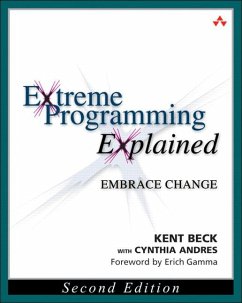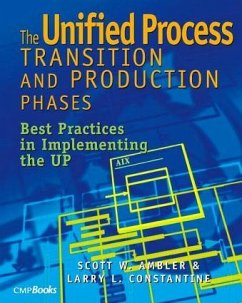Nicht lieferbar

Extreme Programming Installed
Versandkostenfrei!
Nicht lieferbar




Extreme Programming Installed explains the core principles of Extreme Programming and details each step in the XP development cycle. This book conveys the essence of the XP approach--techniques for implementation, obstacles likely to be encountered, and experience-based advice for successful execution.
Ron Jeffries was the on-site XP coach for the original Extreme Programming project, a large financial system for a major automotive manufacturer. An independent consultant who has been involved in eXtreme Programming for over more than four years, he has presented numerous talks and published several papers on the topic. Ron has been a systems developer for more years than most of you have been alive, and his teams have built operating systems, compilers, relational database systems, and a wide range of applications. He has not, as yet, run out of new ways to make mistakes (and resolve them). Ron has recently joined forces with Object Mentor, Inc., to help more people improve their software process. Ann Anderson is an independent consultant engaged full time in coaching XP and in teaching and using Smalltalk for financial applications development. Ann was a team member on the large payroll system that was the original proving ground for Extreme Programming. Throughout her career she has been involved in object-oriented projects spanning control systems, insurance, tax, and finance. Chet Hendrickson is a systems architect at ThoughtWorks, Inc, where he makes sure that programmers and customers know and understand their rights. Previously, Chet was a senior software systems specialist at a major automobile manufacturer, where he worked on a large operational finance system that was the test bed for Extreme Programming. He was the winner of the Project Manager Game at OOPSLA'99 (although he thinks it might have been rigged). 0201708426AB05082001
Produktdetails
- XP Series
- Verlag: Addison-Wesley Longman, Amsterdam
- 2000.
- Seitenzahl: 288
- Erscheinungstermin: 1. November 2000
- Englisch
- Abmessung: 231mm x 189mm x 17mm
- Gewicht: 436g
- ISBN-13: 9780201708424
- ISBN-10: 0201708426
- Artikelnr.: 09295554
Herstellerkennzeichnung
Libri GmbH
Europaallee 1
36244 Bad Hersfeld
gpsr@libri.de
Für dieses Produkt wurde noch keine Bewertung abgegeben. Wir würden uns sehr freuen, wenn du die erste Bewertung schreibst!
Eine Bewertung schreiben
Eine Bewertung schreiben
Andere Kunden interessierten sich für












